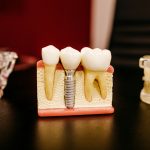
Antiresorptive drugs, used to treat osteoporosis and metastatic bone disease, can complicate dental implant procedures by increasing the risk of medication-related osteonecrosis of the jaw (MRONJ). This systematic review investigates how these drugs affect the success and complications associated with osseointegrated dental implants.
Key findings
- Antiresorptive drugs significantly increase the risk of (MRONJ), accounting for 83% of implant failures.
- Most MRONJ cases occurred in the posterior mandible.
- The average time from starting antiresorptive drug therapy to being diagnosed with MRONJ was approximately 34 months.
- Effective treatment of MRONJ can preserve implants, with 27% of affected implants salvaged and 75% of MRONJ sites achieving complete healing.
Aim
To evaluate the effects of antiresorptive drugs on osseointegrated dental implants, including the characteristics of MRONJ, and provide evidence-based guidelines for dental practitioners.
Methods
- The study protocol was not registered. However, the authors used PRISMA guidelines for the reiew reporting.
- The database search included PubMed and EMBASE, using keywords related to “dental implants,” “antiresorptive drugs,” “bisphosphonates” and “denosumab” up to October 16, 2023. Manual searches were performed in key maxillofacial journals from 2011 to 2023. Reference lists of relevant articles were also reviewed to identify additional studies.
- Eligible studies were those involving clinical trials or case series with at least five dental implants in humans, detailing antiresorptive drug use and documented implant outcomes.
- Data were extracted using a standardised form, capturing author details, publication year, study design, sample size, demographics, type and route of antiresorptive drug administration, implant details, and outcomes.
- Studies were assessed for quality using a non-formal quality assessment tool.
- Due to anticipated heterogeneity, a meta-analysis was not performed.
- A narrative synthesis of the findings was conducted, with results organised thematically and descriptively summarised.
- Subgroup analyses based on participant characteristics were planned.
Results
Description of Included Studies
- The review included a total of eight studies, seven case series and one retrospective cohort study. No randomised controlled trials were identified.
- The eight included studies had a total of 135 patients and 445 dental implants.
Main Findings
- Implant Success and Failure Rates:
- Out of 445 implants, 23% (101/445) failed after the initiation of antiresorptive drug therapy.
- Failures Attributed to MRONJ:
- 83% (76/92) of implant failures were due to MRONJ.
- The remaining 17% (16/92) of failures were attributed to other reasons, such as peri-implantitis.
- Time to MRONJ Development:
- The mean time from the initiation of antiresorptive drugs to the diagnosis of MRONJ was 34 months, with a range from 3 months to 16 years.
- Antiresorptive Drug Details:
- 66 patients received bisphosphonates, and 9 patients received denosumab.
- Of those treated, 61% (54/89) took oral antiresorptive drugs, while 39% (35/89) received them via intravenous or subcutaneous administration.
- Location and Severity of MRONJ:
- Of the 31 implant failures due to MRONJ with specific location data, 65% (20/31) occurred in the mandible, and 85% (17/20) of these were in the posterior region.
- Regarding the severity, 10 cases were classified as Stage 2 MRONJ, and 1 case was Stage 3 MRONJ.
- Treatment Outcomes:
- 27% (21/76) of implants affected by MRONJ could be preserved following treatment.
- 75% of MRONJ sites showed complete mucosal healing after treatment, while the remaining sites were stable with substantial mucosal coverage.
Study citation:
Comments:
The systematic review offers useful insights into the effects of antiresorptive drugs on osseointegrated dental implants, particularly highlighting the risk of MRONJ. However, there are some methodological shortcomings to consider:
- The review’s protocol was not registered, which can raise concerns about the transparency and pre-planning of the research process.
- Only a few databases were searched, potentially omitting relevant studies that could enrich the findings.
- The absence of a standardised critical appraisal tool to assess study quality might undermine the robustness of the conclusions drawn.
Photo credit
Photo by Jonathan Borba on Unsplash
